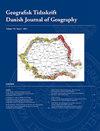这些山被称为家:量化城市森林动态在古瓦哈蒂大都市区,印度的山
IF 1.1
4区 社会学
Q4 ENVIRONMENTAL STUDIES
Geografisk Tidsskrift-Danish Journal of Geography
Pub Date : 2022-07-03
DOI:10.1080/00167223.2022.2157853
引用次数: 1
摘要
森林损失和破碎化是城市景观面临的关键问题。印度古瓦哈蒂都市区(GMA)山区的城市森林经历了重大转变。本研究评估了GMA保护区和非保护区丘陵地区森林的时间变化。利用1976年至2018年的陆地卫星图像,利用景观指标,即景观百分比、斑块数量、平均斑块大小、斑块密度和最大斑块指数,了解森林组成和破碎化的变化。结果表明,由于非森林人为开发活动的增加,GMA的森林正在经历严重的损失和破碎化。1976年至2018年,密林和中密林分别减少了44%和43%,而非森林面积增加了1475公顷。由于小斑块数量从568块增加到780块,密林的破碎化程度增加。今天,茂密的森林斑块仅限于GMA内8个保留森林中的3个。非保护丘陵的非森林土地利用显著增加了139%。因此,受保护和非受保护的森林都遭受了大量损失和破碎。该分析可以使决策者在GMA中优先考虑城市森林保护工作。本文章由计算机程序翻译,如有差异,请以英文原文为准。
These hills called home: quantifying urban forest dynamics in the hills of the Guwahati metropolitan area, india
ABSTRACT Forest loss and fragmentation are critical issues that confront urban landscapes. The urban forests in the hills of the Guwahati Metropolitan Area (GMA) in India have experienced significant transformations. This study assesses the temporal changes of forests in protected and non-protected hills of the GMA. Landsat imageries between 1976 and 2018 were used to understand changes in forest composition and fragmentation using landscape metrics namely, percentage of landscape, number of patches, mean patch size, patch density and largest patch index. The results revealed that the forests of GMA were experiencing intense losses and fragmentation due to increasing non-forest anthropogenic developments. The dense and moderately dense forests declined by 44 and 43%, respectively, as non-forest area increased by 1475 ha between 1976 and 2018. Dense forest demonstrated increasing fragmentation due to the rising number of small patches from 568 to 780. Today, dense forest patches are limited to only three of the eight reserved forests within GMA. The non-protected hills reported a significant 1309% increase of non-forest landuse. Thus, both protected and non-protected forests sustained substantial losses and fragmentation. The analysis could enable policymakers to prioritize urban forest conservation efforts in the GMA.
求助全文
通过发布文献求助,成功后即可免费获取论文全文。
去求助
来源期刊
CiteScore
5.20
自引率
0.00%
发文量
5
期刊介绍:
DJG is an interdisciplinary, international journal that publishes peer reviewed research articles on all aspects of geography. Coverage includes such topics as human geography, physical geography, human-environment interactions, Earth Observation, and Geographical Information Science. DJG also welcomes articles which address geographical perspectives of e.g. environmental studies, development studies, planning, landscape ecology and sustainability science. In addition to full-length papers, DJG publishes research notes. The journal has two annual issues. Authors from all parts of the world working within geography or related fields are invited to publish their research in the journal.

 求助内容:
求助内容: 应助结果提醒方式:
应助结果提醒方式:


